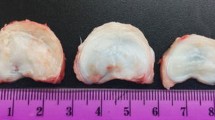Abstract
This study was carried out to determine the effect of age on the intervertebral disc, using a rabbit model. Anulus fibrosus and nucleus pulposus tissue from New Zealand white rabbits aged 3 years old (old rabbits) and 6 months old (young rabbits) were used. The water content, the proteoglycan, the DNA content, and the mRNA levels of aggrecan, type I collagen, and type II collagen were all measured for each sample. Water, proteoglycan, DNA, and the mRNA levels of aggrecan and type II collagen were all greater in the nucleus pulposus of the young rabbits as compared to the old. For the anulus fibrosus, the difference between young and old is less marked with only proteoglycan and DNA being greater in the young disc as compared to the old. Clearly, according to our results, it is the nucleus pulposus that suffers the brunt of the changes with age.
Similar content being viewed by others
References
Antoniou J, Steffen T, Nelson F et al (1996) The human lumbar intervertebral disc: evidence for changes in the biosynthesis and denaturation of the extracellular matrix with growth, maturation, ageing, and degeneration. J Clin Invest 98:996–1003
Antoniou J, Pike GB, Steffen T et al (1998) Quantitative magnetic resonance imaging in the assessment of degenerative disc disease. Magn Reson Med 40:900–907
Antoniou J, Demers CN, Beaudoin G et al (2004) Apparent diffusion coefficient of intervertebral discs related to matrix composition and integrity. Magn Reson Imaging 22:963–972
Boos N, Weissbach S, Rohrbach H et al (2002) Classification of age-related changes in lumbar intervertebral discs: 2002 Volvo Award in Basic Science. Spine 27:2631–2644
Buckwalter JA (1995) Aging and degeneration of the human intervertebral disc. Spine 20:1307–1314
Chandrasekhar S, Esterman MA, Hoffman HA (1987) Microdetermination of proteoglycans and glycosaminoglycans in the presence of guanidine hydrochloride. Anal Biochem 161:103–108
Cs-Szabo G, Ragasa-San Juan D, Turumella V et al (2002) Changes in mRNA and protein levels of proteoglycans of the anulus fibrosus and nucleus pulposus during intervertebral disc degeneration. Spine 27:2212–2219
Ghosh P, Bushell GR, Taylor TF et al. (1977) Collagens, elastin and noncollagenous protein of the intervertebral disk. Clin Orthop (129): 124–132
Gruber HE, Hanley EN Jr (1998) Analysis of aging and degeneration of the human intervertebral disc. Comparison of surgical specimens with normal controls. Spine 23:751–757
Hadjipavlou AG, Simmons JW, Yang JP et al (1998) Torsional injury resulting in disc degeneration. I. An in vivo rabbit model. J Spinal Disord 11:312–317
Kim YJ, Sah RL, Doong JY et al (1988) Fluorometric assay of DNA in cartilage explants using Hoechst 33258. Anal Biochem 174:168–176
Lipson SJ, Muir H (1981) 1980 Volvo award in basic science. Proteoglycans in experimental intervertebral disc degeneration. Spine 6:194–210
Natarajan RN, Ke JH, Andersson GB (1994) A model to study the disc degeneration process. Spine 19:259–265
Nerlich AG, Boos N, Wiest I et al (1998) Immunolocalization of major interstitial collagen types in human lumbar intervertebral discs of various ages. Virchows Arch 432:67–76
Neufeld JH, Machado T, Margolin L (1991) Variables affecting disc size in the lumbar spine of rabbits: anesthesia, paralysis, and disc injury. J Orthop Res 9:104–112
Pedrini-Mille A et al (1990) Stimulation of dorsal root ganglia and degradation of rabbit annulus fibrosus. Spine 15:1252–1256
Roberts S, Menage J, Duance V et al (1991) 1991 Volvo Award in basic sciences. Collagen types around the cells of the intervertebral disc and cartilage end plate: an immunolocalization study. Spine 16:1030–1038
Singh K, Masuda K, Eugene JM, Thonar A, An HS (2008) Age-related changes in extracellular matrix of nucleus pulposus and anulus fibrosus of human intervertebral disc. Spine 34(1):10–16
Sowa G, Vadala G, Studer R et al (2008) Characterization of intervertebral disc aging: longitudinal analysis of a rabbit model by magnetic resonance imaging, histology and gene expression. Spine 33(17):1821–1828
Acknowledgments
The authors thank Jun Li and Yerun Zhu for providing expert techniques.
Author information
Authors and Affiliations
Corresponding author
Rights and permissions
About this article
Cite this article
Murakami, H., Yoon, T.S., Attallah-Wasif, E.S. et al. Quantitative differences in intervertebral disc–matrix composition with age-related degeneration. Med Biol Eng Comput 48, 469–474 (2010). https://doi.org/10.1007/s11517-010-0586-1
Received:
Accepted:
Published:
Issue Date:
DOI: https://doi.org/10.1007/s11517-010-0586-1




